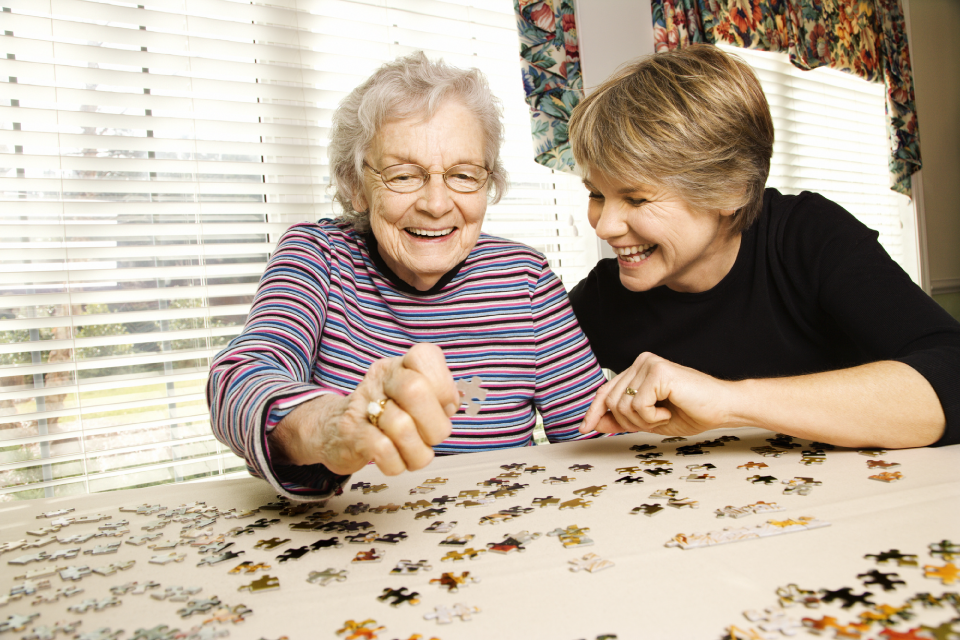47.5 million people live with dementia in the world.
In the United States alone, 5.7 million people live with Alzheimer’s, a specific type of dementia. Alzheimer’s is the most common type of dementia, with one in ten people over the age of 65 affected by it.
If you or someone you love is living with Alzheimer’s, there are some memory care activities you can do to stimulate the person.
Remember, even though the individual may not be the same as they were during most of your life, they are still a person to be treated with empathy, dignity, and respect. Therefore, it is imperative that you continue to do daily activities with them.
You should also remember, that when you’re doing activities with someone who has Alzheimer’s, safety comes first. One day, they may be able to do an activity that they’re unable to do the next day. As such, some activities may not be safe any longer as they continue to progress in their disease.
Be vigilant about safety as you work together.
Choosing Activities
In addition to ensuring that the activities you choose for your loved one are safe, you should also choose activities that reflect their personality. As mentioned previously, your loved one may not be exactly the same as they used to be, but that doesn’t mean their core personality has disappeared.
If your loved one was family oriented, do crafts and activities that include their family or photos of their family. If they loved music, incorporate that into their activities.
They most likely will remember some things from their past, and your activity may just be the key to it.
1. Flower Arranging
If your loved one enjoyed keeping house, flower arranging is a great activity. It engages their minds and allows them to be somewhat creative again.
Bring in pre-cut fresh flowers from a supermarket or from a local farmer’s market. Together, the two of you can arrange flowers in a vase for display. You can also throw in seasonal things, like little pinecones, pumpkins or Santas to make it festive for each season.
You may also arrange faux flowers and create cute little vases or arrangements that will last forever.
2. Drawing
Was your loved one an artist or did she or he love to draw? If so, get out a pen and paper or a sketch pad. You can place something in the middle of the table and ask him or her to draw it. Or, you can even have them draw from photos of their family members or grandchildren.
Their art may not look the way it did when they were younger and more vibrant, but it is a great and safe activity to help them feel cared for and have fun. It may also job memories of some of their times when they were younger, which might bring a smile to their face.
3. Make a Family Scrapbook
Depending on their ability, you can either pre-cut or have them cut out photos use safety scissors. Sit with your loved one and create a scrapbook full of photos of their family and friends that they can look at at a later date.
If they’re still int he early stages of Alzheimer’s, ask them about the people in the pictures. You can ask about their names, their ages and what they’re doing now. If your loved one doesn’t remember, but you do, take the opportunity to have a conversation about them. It may also help them remember certain people and events of the past.
For example, if they’re cutting out a photo of their sister and they don’t remember who she is, tell them about her. Over time, they may begin to remember. If not, they’ll still appreciate the time spent with you as you create a little book of memories.
This is also a great activity to do when a member, or members of their families, are visiting.
4. Easy Puzzles
Puzzles are a great way to improve dexterity and keep anyone’s brain active. While more complex puzzles are great for older people hoping to stave off Alzheimer’s, easier puzzles can help those who already have the illness. They can even be an important part of physical therapy.
For an extra special activity, create an easy puzzle with photos of their families on it. You can do this with a variety of online shops such as Zazzle or Shutterfly.
You can help them put together their puzzle, and discuss the people in the photos.
Or, you can put together puzzles of people and places you know they have a connection to. For example, if they lived in Paris when they were younger, you can put together a puzzle of the Eiffel Tower. Remind them that they once lived near there a long time ago.
If they are lucid, they may be able to tell you a couple of memories about living in Paris, or wherever the puzzle takes place. You can use this jumping off point for almost anything, including dogs and cats and get them talking about animals they once had if they are able.
5. Socializing with Animals
It’s no secret that animals provide great therapy. That’s why dogs and other types of animals are used to attend nursing home events, hospitals and visit children in children’s hospitals. Not only do they bring a smile to people’s faces, but they often jog memories of animals they had in the past, as well as provide a sense of reassurance and comfort.
Many programs offer this service for seniors, so look around in your local area for therapy dogs, or inquire at the care home your loved one lives in. They will likely know of a local service who can help.
If you or someone you love has a gentle dog or cat, you can also bring them to visit your loved one. If your loved one is still in the early stages of Alzheimer’s, he or she can throw the ball to the dog or play with it gently.
But sometimes, even just having an animal sit patiently on their lap is an excellent medicine and an especially memorable activity. Be sure to take a photo of the animal on their lap to show them later and discuss it.
If playing with the dog or cat brings up memories of their dog or cat they had as a child, sit and listen to their stories. Or, if you know they had a dog or cat, ask them if the dog or cat reminds them of them.
Even if the only response you get from having an animal visit is smiling, it will be reward enough and will let you know the activity was a hit.
6. Music Makers with a Homemade Shaker
If your loved one was a big music fan, this is one for them, especially as they begin to decline. Using an empty and cleaned water bottle, put some dried beans or rice in the bottle. Turn on some of their favorite music and encourage them to keep the beat by shaking the bottle.
You can also encourage them to tap their toes and sing along as much as they’re able.
This is also a great activity to plan to do with a group of individuals in memory care if someone comes to play live music for them. This can make the experience a little bit more interactive and help them feel more included than just having someone sing or play to them.
7. Make Dinner, or Include Them in Preparations
Was your loved one a top chef in his or her heyday? If so, include them in making a meal together.
If they’re doing fairly well, they can help as much as appropriate. While chopping vegetables or putting the food in the oven may not be the safest option, you can have them measure items and put them in the pot. They can also stir and help keep items warm.
As their cognitive function declines, you can find alternatives for keeping them involved in preparing the evening meal. This may mean supervising them as they measure out ingredients and put them in the pot. It may mean helping them stir or sift ingredients, as they may not be strong enough to do it on their own.
As they progress in their illness, they may eventually simply fold the napkins or help you set the table. No matter what, ensure that you’re including them and making them feel as if they’re utilizing old skills.
8. Housework
No one likes to do housework, and part of aging means that it often gets neglected. While you can’t rely on someone with Alzheimer’s to do their housework themselves, you can include them in the housework. This is especially the case if the person spent much of their life keeping their home tidy, and was especially proud of it as a younger person.
When you come over to clean, or someone else comes over to do the heavy lifting, enlist your loved one in small activities that they can handle. For instance, have them wipe the counters or the mirrors. Let them do a few of the dishes.
While they may not get a whole lot done when it comes to keeping the house or their apartment spic and span, it’s also about them engaging in the activity and being able to continue to feel useful. That’s much more important than a clean and perfect home.
9. Reading
An individual with Alzheimer’s may still enjoy reading for a long period of time after diagnosis. But, as their cognitive function declines, they may be unable to continue to do so. If they don’t have the ability to read on their own, read to them some of their favorite books or stories. Or, give them books on tape or on an iPad to listen to.
As time moves on, begin to read them progressively simpler stories. If they’re fans of the classics, for example, you will likely be able to find children’s versions of the same stories. They’re often abridged and take thirty minutes or less to read to your loved one. This way, they’ll still get the gist of the story, but won’t have to follow along with the complex nature of the original.
When they become unable to follow along with simple children’s books, you can get them picture books of the same classic stories and favorites. They will enjoy looking at the pictures, especially if you explain to them who is who.
10. Gardening
Many people love to garden as they age, and your loved one might have even had a garden that was their pride and joy. Tending to a garden can help them with their sense of purpose, and is a great activity to help them get outside.
If your loved one is able, help them tend to the garden outside. As they decline, you can make the activities increasingly simple, such as watering plants or placing seeds in pre-dug holes.
As their cognitive function worsens, you can begin activities like planting small indoor gardens, tending to flowers inside or planting small herbs in pots.
Memory Care Activities for Your Loved One
Memory care activities are not simply to keep your loved one busy, but the help them remember who they were and to have a sense of pride about themselves. They can also help by keeping their bodies active and engaged, which can help with physical symptoms like arthritis.





